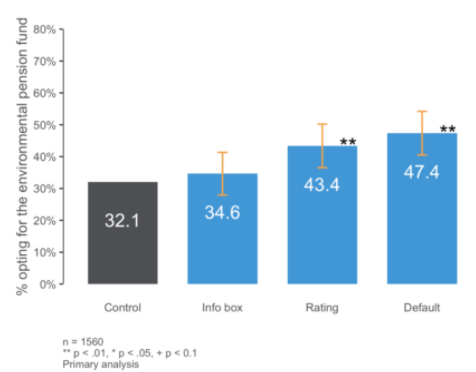A recent survey by Make My Money Matter found that 80% of pension holders have never considered that their monthly contributions might be accelerating global warming. However, when asked, 68% of respondents want their savings to help fight climate change. This shows a gaping mismatch between how consumers would like to invest their pensions and how they are invested in reality.
Whilst the jury is still out on the ultimate impact of green pensions, for now many agree they are likely to be a part of the answer to the challenge of net zero. Behavioural science could help to bridge this gap – pensions were the target of some of the first, and most successful nudges – encouraging people to ‘save more tomorrow’, and in the UK harnessing the power of defaults to help millions more save for retirement. So what could successful green pension nudges look like?
We conducted an online experiment to explore how different ‘nudges’ could encourage more people to take-up green pension funds.
Testing approaches to increase take-up of green pensions
This month, we ran an online experiment with 1,560 English pension-holders to test different framings to encourage people to switch to a greener pension. Respondents were given a hypothetical scenario where they received an email from their HR team which asked if they’d like to switch from their (default) current pension fund to a different fund out of two alternative options. They were randomised into one of four groups: a control group, and three treatment groups (each of which tested a different nudge):
- ‘Red flag’ – The default fund was a standard multi-asset fund. ‘Non-environmental’ funds were labelled with a red flag, and text which warned that ‘This fund invests in businesses whose practices may be harmful to the environment and/or who work in sectors with high carbon emissions.’
- ‘Star rating’ – The default fund was a standard multi-asset fund. Each fund was labelled with a star rating according to its environmental impact. The ‘environmental fund’ had five stars, while the other two had one star.
- ‘Green default’ – Environmental fund was pre-selected as the default.

Afterwards, participants also answered several survey questions about their attitudes towards green pensions.
We found that star ratings and green defaults significantly increase the number of people who opt for the ‘environmental’ pension fund
Both the ‘star rating’ and ‘green default’ conditions led to a statistically significant increase in the number of respondents who indicated they would switch to (or keep) the green pension option. The ‘green default’ led to a slightly greater increase (47.7%) than the ‘star rating’ (35.2%). However, the ‘red flag’ condition had no significant impact on the number of respondents who said they would switch to an environmental fund.

We also found that people are open to being ‘nudged’ about switching to green pensions:
- 68% think pension providers should provide environmental ratings on all funds
- 66% think pension providers should provide information on the potential harms caused by non-environmentally-friendly funds
- 58% think pension providers should provide environmentally-friendly funds as a default
- 55% don’t know whether their current pension fund is invested in an environmentally-friendly manner
Next steps
Our results provide promising evidence that green pension defaults and star ratings can increase the number of pension-holders who ultimately choose to switch to a greener option. Moreover, people seem to be up for these ‘nudges’ helping them to make more sustainable pension choices – giving a mandate for more intervention and research in this space.
In practice, defaults are likely to have an even stronger effect, given not all real-world employees would engage with an email on this topic, and switching would incur more hassle than it did within the experiment. This would reduce the number choosing the green fund within the control, info box and rating conditions, and increase the number within the green default condition. Nonetheless, the relative impacts of these interventions is still informative, showing their potential in the real world.
If you are a policy-maker, pension fund provider or a workplace providing pensions for your employees and would be up for implementing and rigorously testing these and similar behavioural ideas, please get in touch with kristina.londakova@bi.team.








